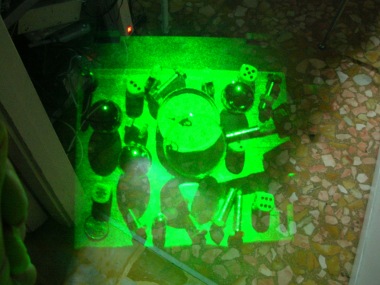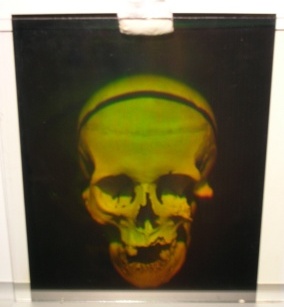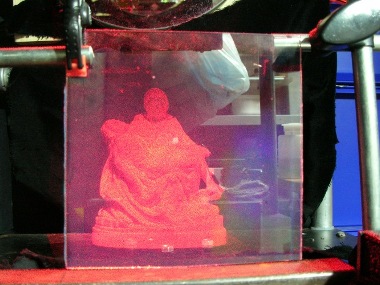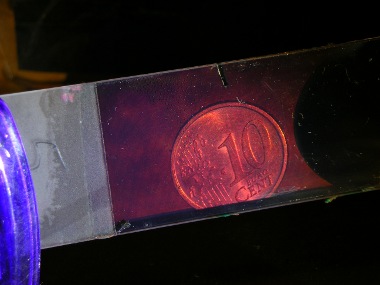
Holograms can be made on many photosensitive supports. I
tried two of the most diffused holographic supports: Silver
Halide Emulsion and Methylen Blue Dichromated Gelatins. To
finance my expensive hobby of Emulsion Maker, I sold most of my
best Holograms, so here I put only a few Laboratory samples just
for your evaluation.
Transmission holograms
Holograms here pictured are made using a Helium Neon Laser and
red sensitive Homemade Holographic Plates. Thanks to ultrafine silver grains
dispersion and the optimal chemical processing, the final holograms are
perfectly clear and transparent, no traces of Optical Noise (haze) is visible if
viewed using green light too.

Here is another Transmission Hologram. In this picture the Hologram is
illuminated by a low power Green Laser Pointer. The Laser has been
expanded sufficiently to light up all the recorded surface of
the Homemade Holographic Plate. Note how the image is so clear
and haze-free althought viewed in green light, the total absence
of scattering is due to ultrafine silver grains dispersion and
proper chemical treatment.
reflection holograms on silver halide plates
The holograms here shown are made on glass plates coated with red
sensitive Silver halide emulsion. A 20mW Heliun Neon Laser is used to expose
the plates using the single beam technique.
As a rule of thumb
using said laser the exposure time for a 230x250 millimiters
homemade holographic plate is about 45 seconds if the single
beam configuration (denisyuk) is chosen.

Contact copy of White Light Reflection Holograms made with
homemade holographic plate
(Courtesy of Mauro Melotti -Italy-)
reflection holograms on
methylen blue dichromated gelatins
Diffraction efficiency of Menthylen Blue Dichromated Gelatins (MBDCG)
is simply astonishing. Unfortunally poor shelf-life, low sensitivity of about
50mJ/cm^2, and tricky developing procedures, make this technology poorly
diffused among hobbists.
Using a 20 mW Helium Neon Laser typical exposure
times for 200x200 mm plates are approximately of 20
minutes.

Transmission Hologram. This Holograms can be seen using a
monocromatic light source such as the Laser user to make the
Hologram itself. The Hologram here picturec is made using the Dual
Beams Configuration. Despite the intrinsic limitations of this kind
of hologram, the reproduced image is highly realistic, sharp and
deep.

White Light Reflection Holograms are usually back painted with
acrylic black canned paint. Back painting gives more stability to
the emulsion and protection against scratches and abrasions. Another
important effect of back black painting is a phisical dark
background on which the holographic image can be seen without
interferences from the surrounding environment as walls, light
sources, light reflected by objects. Anyway if the Diffraction
Efficiency of the holographic support if high, the environmental
conditions are almost insignificant as it can be seen on the above
picture.

This white light reflection hologran is made exposing the
plate with the light generated by a homemade Ruby Laser. As
discussed in the Laboratory section,
this laser wasn't designed for holographic pourposes, but it
unexpectedly worked when trying to make the hologram of a coin.

White Light Reflection Hologram made on MBDCG support. In order
to get a so bright image, the 230x180 millimeters plate should be
exposed at least for 18 minutes with a 20 milliwatt helium neon
laser.






